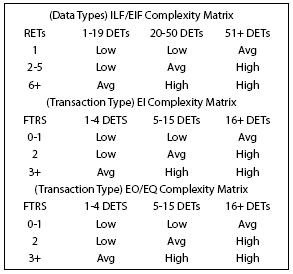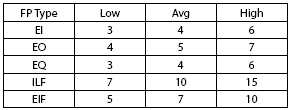|
Introduction
to Function Points
By
Sheila P. Dennis and David Garmus, David Consulting
Group
IBM first introduced the Function Point (FP) metric in 1978
[1]. Function Point counting has evolved into the most
flexible standard of software sizing in the information technology
(IT) domain today.
There are several characteristics that account for the
flexibility which drives the popularity and usage of the function
point methodology, but the foremost appeal is the ability to measure
the size of any software deliverable in logical, user-oriented
terms. All sizing is based upon identifying, evaluating and
weighting functional entities (inputs, outputs, inquiries and data
usage) in an application or project from a user perspective. The
term user is defined to be any person and/or thing that interacts
with the software. Clearly, the user could even be another system or
even a machine. By applying this approach, function points can be
universally applied regardless of platform, environment, language,
or other technical considerations.
Using Function Points
The IT industry, including the
Department of Defense, has successfully used function point analysis
to size a wide spectrum of applications and projects, including
general business, complex financial and accounting, logistics and
communications systems. It has been proven on a variety of
development platforms and/or environments (e.g. mainframe,
client-server, web, stand-alone PC, data warehouse); for a variety
of development types (real-time, batch, interactive or control
systems); for internal or external development efforts (e.g.
on-shore, off-shore, contractor-based); and for vendor and/or COTS
package integrations.
As projects are completed and software deliverables are produced,
function point sizing, together with a collection of other
meaningful measures, can be used in a variety of initiatives.
?Balance Scorecard. Using function points as the basis for size
normalizes metrics across platforms and projects. Measures based
upon function point sizing [e.g. delivery rate (hours/function
point), defect rate (defects/1000 function points)] are currently
being used as the cornerstone at select DOD installations supporting
the enterprise IT Balance Scorecard.
?Benchmarking. Measuring
DOD抯 IT performance against competing outsourcing environments, as
well as other governmental organizations, has become increasingly
important in identifying opportunities for improvement in time to
delivery, cost reduction, and customer satisfaction. Cost per
function point delivered and function points supported/developed per
Full Time Equivalent are only two of many metrics used in current
benchmark initiatives.
?Outsourcing Service Level Agreements.
Commercial and governmental uses of delivery rates by platform and
defect density are effective in providing a contractual basis for
performance standards for outsourcing requirements when function
points are used as the common size measure.
Function Point Counting Process
The function point counting
practices are governed by the International Function Point Users
Group (IFPUG), a not-for-profit organization, consisting of IT
measurement industry leaders and practitioners from over 30
countries. For more than 25 years, IFPUG has maintained the
guidelines and rules for counting practices through committees whose
members have extensive software development and measurement
expertise. Each new edition, or version, of the rules (currently
version 4.2) is verified by the IFPUG body through practical
application and statistical methods to ensure consistency, usability
and reliability. In this section, we will provide an overview of the
counting process using simple counting examples. The counting
process included in this article is not all-inclusive and must be
complimented with the rules as defined in the IFPUG Counting
Practices Manual [2].
The function point method evaluates the software deliverable of a
project and measures its size based on well-defined functional
characteristics of a software system [3]. Therefore, one of the
first steps in counting is to identify the functional processes of a
project and categorize them into function point entities. After the
identification, a complexity level (Low, Average, High) is evaluated
for each of the entities, and then assigned a weight (3 - 15 points)
based upon complexity. For simplicity, we will use examples based
upon a Human Resources (HR) system.
Identifying and Classifying. The two major functional
characteristics that are considered in function points are data
types (files, tables, records) and activity-based transaction types
(inputs, outputs, queries).
Data types are user defined and recognized logical data groups of
data, usually physically stored as files or tables. We classify the
data into two separate categories, internal and external.
?Data manufactured and stored within the system are internal
logical files (ILFs). For HR, employee data would be an
ILF.
?Data maintained within a different system but necessary to
satisfy a particular process requirement are called external
interface files (EIFs). For HR, IRS tax tables could be a potential
EIF.
Transactional types are elementary processes that control,
maintain or display data. We classify transactions according to
whether they relate to data entering the system, or leaving the
system.
?Data entering a system are called external inputs (EIs). For HR,
examples of EIs could be (1) an incoming feed from another system or
(2) adding an employee through screen entry.
?Data leaving the
system are classified as external outputs (EOs) or external
inquiries (EQs). For HR, an online display of employee data would be
a typical EQ. Reports or feeds to other systems are also EOs or
EQs.
Evaluating Complexity. After the logical entities for a project
are classified into the function point entities (ILFs, EIFs, EIs,
EOs, and EQs), a complexity level of low, average or high is
assigned using IFPUG derived complexity matrices (Figure 1). The
matrices are dependent upon the components of data types and
transactions.
?Record Element Types (RETs) are mandatory or optional sub-groups
of data.
?Data Element Types (DETs) are non-repeated fields or
attributes.
?File Types Referenced (FTRs) are the internal or
external data types (ILFs or EIFs) that are used and/or maintained
by the transaction.
The number of different Record Element Types, and unique Data
Element Types used and/or maintained, determine the complexity of
data types. However, the complexity of transaction types are
determined by the number of data types referenced (ILFs and EIFs)
and unique Data Element Types. In general, the higher use of
components results in a higher complexity.
?For the HR system,
assume that 揈mployee Data?has two groups of data, employees and
dependents, with a total of 35 unique, non-repeated, user
recognizable fields. Then 揈mployee Data?would be rated Average.
?If the transaction to add an employee (EI) had at least 16
unique fields to enter on the screen in order to update 揈mployee
Data? and 揈mployee Data?was the only type of internal or external
data to be used in this process, then the complexity would be based
on 1 FTR with 16+ DETs, or Average.
?An HR report of employee
tax data (EO) having 16 or more unique data fields, and using both
the 揈mployee Data?and the external data from the IRS Tax tables,
would be of High complexity.

Figure 1. Complexity Matrices
[2]
Assigning Weight. Once the complexity is identified, values for
each entity are assigned using the IFPUG standard weights shown in
Table 1.

Table 1. Function Point Counting Weights
[2]
In the HR application, the previously identified entities would
be weighted as follows:
?Employee Data (ILF) - Avg - 10 function
points
?Add an Employee (EI) - Avg - 4 function points
?Employee Report (EO) - High - 7 function points
Calculating
a Project Count. Assuming that the three functional processes listed
above represented the requirements for a project, then the total
unadjusted count for the project would be the sum of all the
entities, or 21 function points.
At this milestone of the counting process, there is a Value
Adjustment Factor (VAF) factor that is used to adjust the project
count. The VAF, with a range of .65 to 1.35, is derived from
evaluation of fourteen (14) General System Characteristics (GSCs)
based upon the technical characteristics of the application. Complex
processing, distributed processing, online data entry, security
influence and transaction rates are a few of the aspects considered
in the GSCs. In the HR project, if the GSC for HR was 1.1, then the
project count would be adjusted by multiplying the unadjusted count
(21 function points) by the GSC (1.1) for an adjusted total project
count of 23 function points.
The final function point calculation yields a single number that
represents the total amount of functionality being delivered. Once
completed, the function point size of an application or a new
development project can be communicated in a variety of ways. As a
stand-alone value, the function point size of a system tells us how
large the overall software deliverable will be. When the function
point value is segmented into a more detailed display, it can
communicate to end users the functional value of specific components
of the system. Finally, more mature software measurement
organizations can use function points to predict outcomes and
monitor program progress.
Summary
Function points is the most effective and flexible way
of normalizing critical measures in the successful management and
monitoring of both internal measurement initiatives and outsourcing
arrangements. Use of function points as the standard size component
of cost and quality measures can satisfy both the IT organization抯
need to monitor the outsourcing contract and the user抯 need to
ensure the value of the deliverable. In addition, the use of
function points provides the opportunity to make comparisons to
industry performance levels.
About the Author
Sheila P. Dennis is a managing senior
consultant for the David Consulting Group (DCG). She is the Past
President of the Rocky Mountain Function Point Users Group, has
served on two International Function Point Users Group (IFPUG)
committees, and has been a Certified Function Point Specialist for
over 10 years. She came to DCG in 2004 after retiring from the
Defense Finance and Accounting Service (DFAS). During her tenure at
DFAS, she moved from software engineer to process engineer in 1993
when she was chosen as the organizational representative for the DOD
Software Measurement Pilot, a collaborative effort of DOD and the
Software Engineering Institute (SEI). She eventually became the
manager of the process improvement (CMM), quality assurance and
metrics programs for an organization of approximately 120 civilians.
Her unit supported a portfolio of over 400,000 function points
representing a variety of platforms and applications. She is
currently an active consultant, conference speaker, and workshop
teacher. She was a contributing author to IT Measurement - Advice
from the Experts (Addison-Wesley, 2001) and a contributing editor of
Guidelines to Software Measurement (IFPUG, 2003). She holds a
Certificate of Management Studies from Golden Gate University and a
B.A. in General Studies (Mathematics) from Columbia College.
Author Contact Information
Email: sdennis1950@yahoo.com
References
[1] Jones, Capers, 揟he Expanding Roles of
Function Point Metrics? IT Measurement ?Practical Advice from the
Experts, Addison-Wesley, 2002
[2] Function Point Counting
Practices Manual - Release 4.2.1, International Function PointUsers
Group, 2006
[3] Herron, David and Garmus, David, Function Point
Analysis - Measurement Practices for Successful Software Projects,
Addison-Wesley, 2001 |
|




